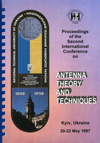Entrance intercavitary impedance electrodes matching for local heating of neoformations in biological tissues
DOI:
https://doi.org/10.1109/ICATT.1997.1235251Abstract
Theoretical studies and research work on the matching of the intercavitory applicators' system with the source of radiofrequency (RF) current has been conducted recently. As the result of these studies was developed the system of isolated and not isolated from the surrounding tissue applicators and the method suitable to control the modifications of the complex phantom's permittivity. The method is based on the measurement of the complex input conductivity in the coaxial line partly filled with phantom.References
Chou, C.-K. Phantoms for electromagnetic heating studies. Physics and Technology of Hyperthermia. Boston: NATO, 1987 [ed. by S.B. Field].
Pagliole, W. Power Deposition with Microwaves. Physical Aspects of Hyperthermia. N.Y.: American Institute of Physics, 1982 [ed. by G.H. Nussbaum].
Stuchly A.; Stuchly, S.S. Coaxial Line Reflection Methods for Measuring Dielectric Properties of Biological Substances at Radio and Microwave Frequencies-A Review. IEEE Trans. Instrum. Meas., 1980, Vol. IM-29, No. 3.
Published
1997-05-24
Issue
Section
Microwave technologies application

